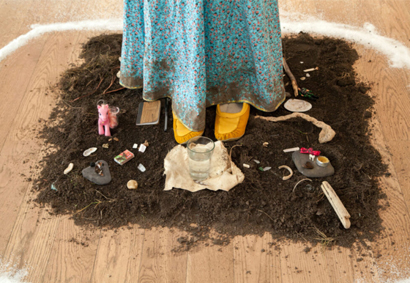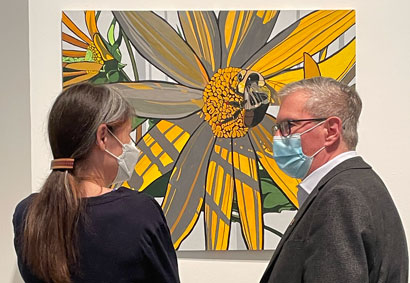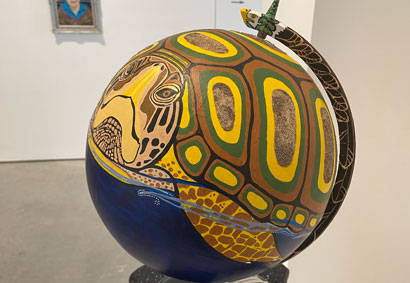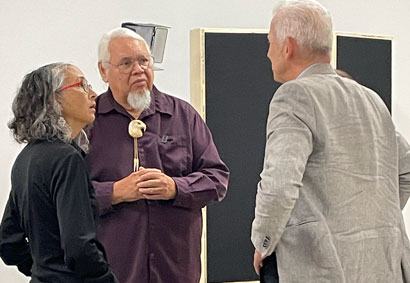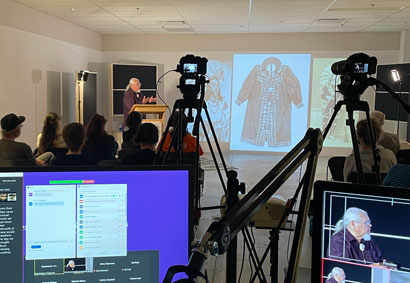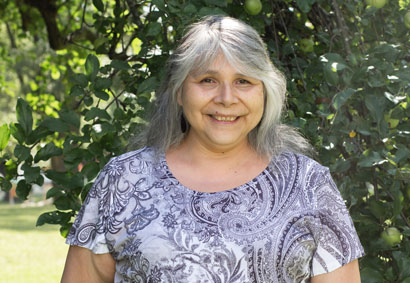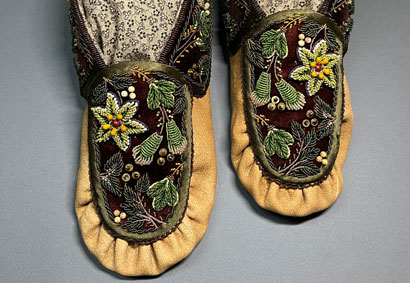Indigenous Artist-in-Residence
Call For Applications:
Applications for 2026/2027 due January 15, 2026
Call for Applications: Indigenous Artist and Residence 2026/2027 (PDF)
Program Description
The Department of Visual Arts at Western University is seeking applications from emerging to established Indigenous artists, including individuals and collectives, for the one-year Indigenous Artist-in-Residence (IAiR) program. This program will support a First Nations, Métis, or Inuk artist in the research, creation, and production of new artistic work. The IAiR will work closely with the Department of Visual Arts and undertake community engagement or other outreach activities, that could include (but are not limited to) artist talks, workshops, studio visits, collaborating with the Office of Indigenous Initiatives, or exhibiting at the ArtLAB. Applications from artists with connections to, or living in, the region are particularly encouraged. Projects that incorporate distance or remote components, or other innovative virtual forms of residency, are welcome.The IAiR position includes access to studio space, equipment, staff support, and other resources at Western University, such as use of the library. It will include periodic activities that intersect with coursework and departmental events. There is an option to develop and teach a course in the Winter term during the residency should the successful candidate be interested, which would be funded separately. If required, the Department will provide support for developing the course.
The residency will be situated in the Department of Visual Arts for a period of 8 to 12 months beginning August 1, 2025 (negotiable). The stipend for this position is $50,000 (inclusive of taxes) regardless of the length of the residency, number of individuals involved (in the case of a collective), and is intended to cover support materials, travel, accommodation, artist fees and costs related to the residency, although additional funds can be applied for through the Department.
The Department of Visual Arts has strengths in digital media, photography, painting, drawing, printmaking, sound, sculpture, and installation. Department facilities include the ArtLAB Gallery, the Cohen Explorations Lab and Cohen Commons, the Centre for Sustainable Curating, as well as studio facilities including woodshop, sound studio, printmaking studio, painting studio, dark room, and black box media lab. The Department of Visual Arts supports numerous projects committed to social and environmental justice and would welcome the successful candidate’s potential input and/or collaboration in these areas.
Local Context
Western University is located on the traditional lands of the Anishinaabek, Haudenosaunee, Lūnaapéewak and Chonnonton Nations, on lands connected with the London Township and Sombra Treaties of 1796 and the Dish with One Spoon Covenant Wampum.
With this, we acknowledge and respect the longstanding relationships that Indigenous Nations have to this land, as they are the original caretakers. We acknowledge historical and ongoing injustices that Indigenous Peoples (First Nations, Métis and Inuit) endure in Canada, and we accept responsibility as a public institution to contribute toward revealing and correcting miseducation as well as renewing respectful relationships with Indigenous communities through our teaching, research and community service.
The Department of Visual Arts is located next to the Deshkan Ziibing, also known as the Thames or Antler River. This culturally and ecologically significant river reminds us of our responsibilities to the land and Indigenous Peoples, and offers meaningful grounding and inspiration to many students, staff and faculty.
Current Indigenous Artist-in-Residence
2025/26 Jodi Lynn Maracle
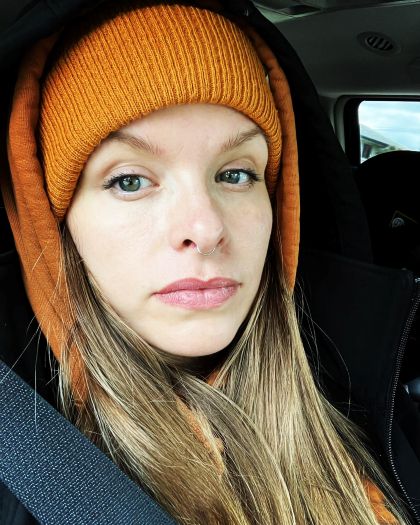
Born and raised in what is currently considered Buffalo, NY, Jodi Lynn Maracle is a mixed Tyendinaga Mohawk/settler artist, hide tanner, doula, actor, teacher, parent and Kanien’kéha language teacher and learner. Jodi utilizes Haudenosaunee material language and techniques, such as hand tanned deer hides, in conversation with sound scapes, projections, video and performance to interrogate questions of place, power, erasure, story making, and responsibility to the land. Jodi’s work pushes against imposed settler-colonial presumptions of value, worth, progress, and time, as well as violent kinship models, highlighting precarity, impermanence, and cyclical relationships across generations in relationship to that which sustains us. Her most recent work investigates the embodied practice of hide tanning utilizing traditional materials, methods, and medicines as well as exploring deer hide as a medium in new forms.
Jodi has shown her work throughout Dish With One Spoon Territory in site specific installation performances such as the Mush Hole Project at the defunct Mohawk Institute Residential School (home of the Woodland Cultural Centre), the Gardiner Museum in Toronto, ON, Artpark in Lewiston, NY, the Burchfield-Penney Art Center in Buffalo, NY and has works in the permanent collections at the Seneca-Iroquois National Museum in Ohi:yo’, the University at Buffalo’s Anderson Gallery and the AKG Buffalo Art Gallery.
Through her relationships with hide tanners from other Indigenous nations, archival research, museum visits, the generous expertise of knowledge holders and experiential practice, Jodi hopes to help revive hide tanning across Haudenosaunee territories and beyond. By grounding in ancestral teachings, Haudenosaunee stories and ceremonies, it is her hope that this important practice can return to community knowledge bases within Haudenosaunee communities. As part of her residency at the University of Western Ontario, she will not only be creating sculptures out of deer hide but will also be offering a hide tanning camp and presentations centered on the material and cultural importance of hide tanning.
Jodi views the hide tanning process as a central component to understanding historical and contemporary responsibilities and relationship to Indigenous peoples’ respective homelands across time. As part of this, she will create a series of sculptural objects in forms not generally seen with deer hide as the primary medium. Utilizing only our ancestral materials, she will not only create sculptural objects grounded in Haudenosaunee teachings, but will also document the process through creative audio and video recordings to be utilized in conversation with the sculptural objects.
Western News: Meet Jodi Lynn Maracle, 2025-26 Indigenous Artist-in-Residence
Past Indigenous Artist-in-Residence
2024/25 Theo Cuthand
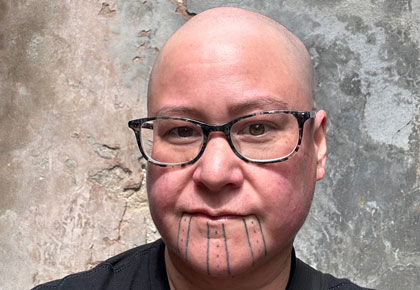
“I work in film/video art and indie video game development. My work grapples with issues related to the Indigiqueer/Two Spirit community and the larger communities of Indigenous and Queer/Trans people we inhabit. I’m currently interested in themes of complicity with colonial resource extraction, Queer and Trans desire, ethics of negotiating needs/desires in communities, climate change, and repatriation. I have a history with punk aesthetics of DIY video art which I have leveraged to make many short videos on extremely low budgets. I’ve also used punk zine aesthetics in my video game art, including the rough cut and paste aesthetics seen in my game Bipolar Journey. As my access to funding and technology increased, I have moved into digital illustration for my newest video game Carmilla the Lonely. I often incorporate older technologies into digital work, such as utilizing Super-8 film in my videos Medicine and Magic, Medicine Bundle, and 13 Eggs."
"I’ve developed a diaristic feel to my videos which people receive as confessional stories. I find using a personal tone to the larger themes of living as an Indigiqueer person in a huge settler colonial project helps people connect to issues that seem more abstract."
"My next video game work looks at issues of repatriation and Indigenous bodies being held in museums. As part of any work, I do a lot of research into the issues at hand. For a current project I hope to visit museums doing repatriation work with Indigenous communities, so that I can create a video game called Repatriate Me. Repatriate Me is a video game about a nêhiyaw trans man’s spirit trying to fight his way to the director’s office to convince him to repatriate his bones back to his home community in Saskatchewan, Canada."
"I am also largely known for my experimental documentaries, including the NDN Survival Trilogy (Extractions, Less Lethal Fetishes, Reclamation). Another current experimental doc I am working on now is called “Whatever Happened To Baby Dyke?” which explores my current transition from butch lesbian to bisexual trans man. This video is composed of various documented photos and voice memos as my body has changed, which are interrupted by alarming headlines from the anti-Trans right wing backlash currently fueling discrimination against people like me in multiple countries."
"I also talk a lot about Madness and my experiences as a Mad Indigenous artist, including in my videos Sight and Love & Numbers. These works can be challenging and disturbing but hopefully also serve as comfort to those still struggling with their mental health."
"I look forward to a future continuing to create difficult, amusing, honest work."
Western News: Indigenous artist-in-residence used film and video games to connect with students
Doris McCarthy Gallery | Love + Numbers: The Videos of Theo Jean Cuthand by Wanda Nanibush
Theo Jean Cuthand: Love + Numbers, January 18 - March 29, 2025, Doris McCarthy Gallery
Indigenous Casting Call Workshop with Theo Cuthand, March 23, 2025
In Conversation: Theo Jean Cuthand and Wanda Nanibush, March 29, 2025, U of T Scarborough
Theo Jean Cuthand: Video Frames and Video Games, April 24 - May 15, 2025, artLAB Gallery
2023/24 Leith Mahkewa
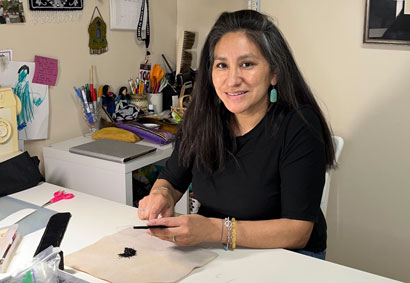
“I am a beadwork artist from the Oneida Nation of the Thames in Ontario. I have been living in the Kanien’kehá:ka (Mohawk) Territory of Kahnawake (Quebec) for 38 years. After graduating from university, I focused on learning Kanien’kéha (Mohawk language) and raising my children as first-language speakers. As a new mother, my passion grew for the Haudenosaunee beadwork that often adorned the clothing of newborns and some of the older people I met in the longhouse. In 2000, I became a member of a ladies’ beading circle which focuses on Kanien’kehá:ka style raised beadwork, a three-dimensional art form having its origins in the Victorian era. It is here that I became a mentee to these seasoned beadworkers."
"I created a niche unique to my Oneida/Chippewa/Hopi/Tewa family lineage. My personal style often juxtaposes the geometric shapes found in my Hopi family pottery patterns, and Haudenosaunee inspired floral designs. The complexity of both cultures and design styles, when combined and manipulated, create a one of a kind form of beadwork."
"My art makes a social statement that speaks to the current social realities of Indigenous life, whether the devastating lack of access to clean water or the effects of the Covid 19 pandemic. The beaded mask “I am protecting you from me”, a piece created to acknowledge the loss of life during the early stages of the Covid 19 pandemic, uses red monochromatic beads representing the blood that flows through us and how we are interconnected to each other and our environment. I am proud to be part of the revival of raised beadwork within the Haudenosaunee Confederacy. I will continue to create pieces that highlight my cultural values and the integrity I have as a strong Onkwehón:we woman.”
The Gazette | Leith Mahkewa, Western's Indigenous Artist-in-Residence, is weaving a path home
The Gazette | Preview: Visual Arts department to host Indigenous artist-in-residence Leith Mahkewa
2021/22 Kelly Greene

First American Art Magazine | Reports: Kelly Greene, Artist Residency, Western University
Education News Canada | Kelly Greene first Indigenous artist-in-residence
Centred.ca | Review of Continuing Accountability - Kelly Greene
Western News | Kelly Greene first Indigenous artist-in-residence
Upcoming Exhibitions and Events
Exhibitions and Events Archives
Theo Jean Cuthand: Video Frames and Video Games, April 24 - May 15, 2025, artLAB Gallery
In Conversation: Theo Jean Cuthand and Wanda Nanibush, March 29, 2025, U of T Scarborough
Indigenous Casting Call Workshop with Theo Cuthand, March 23, 2025
Artist Talk by Theo Jean Cuthand, January 29, 2025, Doris McCarthy Gallery
Theo Jean Cuthand: Love + Numbers, January 18 - March 29, 2025, Doris McCarthy Gallery
Rick Hill: How the Foundations of Haudenosaunee Aesthetics Survived Colonization, September 21, 2022
Kelly Greene: Continuing Accountability, April 21 - May 17, 2022, Artlab Gallery
Eagle Flight Singers, April 7th, Artlab Gallery
Partricia Deadman: A Brief Introduction to the Development of Indigenous Art History in Canada, November 10, 2021
